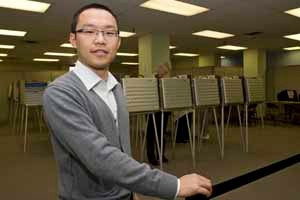
New Voting-Machine-Allocation Method Could Reduce Voters' Wait Time by 36 Percent
With a lifelong interest in politics, University of Cincinnati researcher Muer Yang spent the last two years developing a quantitative method for allocating voting machines that could significantly reduce the average wait time of voters.
During the 2004 U.S. presidential elections, some voters waited in lines for more than 10 hours to cast their ballots, and in Ohio, the last vote was cast at 4 a.m., noted Ohio Secretary of State Jennifer Brunner in a public
. Ohio lines in the '06 and '08 elections were still so lengthy that they essentially "disenfranchised" voters unable to wait that long, said UC College of Business PhD candidate Yang. He wanted to change that.
To test his method in a computer-simulation model, he used 2008 presidential election data from Franklin County, Ohio, and found that, under simulations, his allocation method reduced the average voter wait time by 36 percent and specifically reduced queuing times for 23,000 people who had to wait for more than 30 minutes in that election.
His intention was to find a way to allocate voting machines to polling locations "so that all voters wait approximately equal amounts of time regardless of the precinct in which they happen to vote," Yang said of the
quantitative analysis and operations management
research he is conducting with program director David Kelton, UC associate professor Michael Fry and Ohio State University associate professor Theodore Allen. "We seek to provide equity to all voters so that no one particular group of voters is disadvantaged or disenfranchised," Yang said.
Election boards traditionally use a simple straight-forward mathematical model to allocate voting machines within a precinct, based on the number of voters and available machines, he said. "And that looks very fair, but they oversimplify the problem.
"Their assumptions of those problems are not even close to the real world," he added, "because that model assumes a stationary voter arrival that voters arrive at the voting station at the same rate, which is not true. We use simulation models to consider realistic complications, including variables such as voter arrival time, voter turnout, length of time needed to finish a ballot, peak voting times and machine failures."
Those numbers can vary significantly between precincts.
Franklin County's voter-machine allocation method is typical to what is used in many areas of the country, but the Ohio county had several characteristics that made it a prime choice to test: It contained an urban core, suburbs and rural areas, leading to a highly diverse voter population, as well as the potential for significant differences in ballot composition.
As if validating Yang and his professors' test case selection, Secretary of State Brunner issued a
last year stating, "Franklin County voters suffered from one of the most disproportionate allocations of voting machines last November. Race and income may have also factored into the wait, according to some election observers."
Last, and just as important, "Ohio, and Franklin County in particular, have been pivotal in recent presidential and congressional elections," Yang said. In August, Time magazine called Ohio "the grand prize of presidential politics."
While conducting the research, the UC team worked closely with Brunner's office, and last fall they were directly involved in providing advice to modify Ohio legislation regarding the allocation of voting machines. House Bill 260, which comprises sweeping election reform well beyond the issue of voting machines, passed through the House of Representatives, but has not made it through the Senate.
Nevertheless, Yang has been excited to see officials take his work seriously. "The local board of elections was really happy that we could provide them with a new easy-to-use tool that didn't ask them to buy more machines," he said. "Our final goal was to provide them with an impartial, practical tool that could be of significant social importance. And they were glad to see that."
Research has concluded, and
is anxiously awaiting word on the team's submission to the field's leading journal. Last year, they presented a working paper at the 2009 Winter Simulation Conference.
Related Stories
Student Body Vice President grateful for scholarship
April 9, 2025
For many college students, financial barriers often dictate their paths, limiting opportunities, shifting career goals, and reducing involvement on campus. But for Khalid Davis, Bus ’25, scholarships changed everything, turning aspirations into reality and opening doors he could never have imagined.
UC grad takes liberal arts path to study medicine at Johns...
April 9, 2025
A career in healthcare has numerous different pathways and not each one is the same. Some students choose the traditional track, while others try a different approach to success. Jordan “Mint” Sewell can attest to this.
How color cosmetics merge form with function
April 9, 2025
The University of Cincinnati's Kelly Dobos was a featured expert in a Cosmetics & Toiletries article explaining trends and innovations in color cosmetics.
